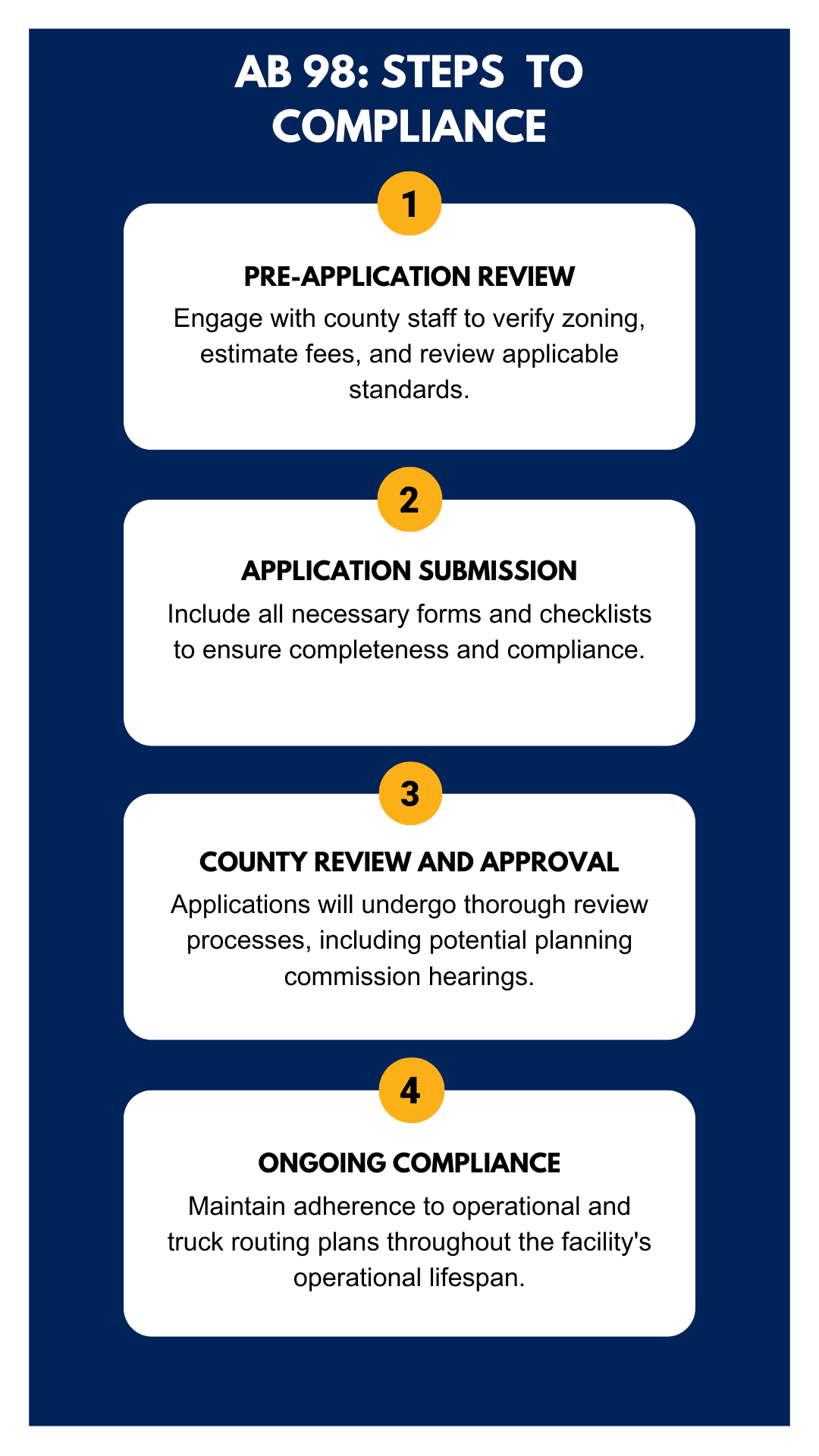AB 98: Enhancing Environmental Standards for Logistics Facilities
Overview
Signed into law on September 29, 2024, California Assembly Bill 98 (AB 98) introduces stringent environmental and operational standards for large logistics use facilities in California. This legislation aims to reduce traffic congestion, air pollution, noise, and light pollution near sensitive areas such as schools, residences, and parks.
| AB98 Resources | Download |
|---|---|
| AB 98 Submittal Checklist | |
| AB 98 Quick Reference Guide |
Key Requirements
AB 98 applies to new and expanding logistics facilities located within 500 to 900 feet of sensitive receptors, as defined by Government Code 65098(e). Facilities must incorporate advanced design features, maintain designated truck routes, and develop operational plans to mitigate environmental impacts. Specific requirements include:
- Strategic siting on designated truck routes.
- Placement of truck loading bays and driveways to minimize proximity to sensitive receptors.
- Installation of solid decorative walls or landscaped berms for buffering.
- Implementation of anti-idling measures.
Applicability
The law targets new construction and expansions of logistics facilities in Warehouse Concentration Regions, with San Bernardino County being a primary example. Facilities must meet all local and AB 98 specific requirements.
Exemptions and Compliance
Existing facilities expanding less than 20% or those already compliant with certain conditions may be exempt. New applications submitted after September 30, 2024, must comply with AB 98 standards.

Frequently Asked Questions
AB 98 is a law that sets new environmental and design standards for logistics use facilities near sensitive receptors to mitigate impacts such as traffic, air pollution, and noise. Please refer to State Government Code Section 65098 for more information.
A sensitive receptor may include residences, schools, daycare facilities, parks, playgrounds, nursing homes, and hospitals. Specific definitions outlined under State Government Code Section 65098(e)
AB 98 applies to new and expanded logistics use facilities within 500 or 900 feet of sensitive receptors like schools and residential areas. It includes requirements for site design, truck routes, and operational plans.
Yes, facilities with expansions less than 20% of the floor area, excluding office space, and new mixed-use developments not impacting sensitive receptors within 900 feet of loading bays are exempt. Facilities served by rail are also exempt.
Applications submitted before September 30, 2024, are not subject to AB 98. Applications between September 30, 2024, and December 31, 2025, need to comply with AB 98. From January 1, 2026, onwards, all new or expanded logistics facilities must adhere to AB 98 standards.
Facilities must meet energy efficiency measures, including PVC systems, cool roofing, electric vehicle charging stations, and efficient lighting. Larger facilities require additional features like microgrid-ready systems and advanced metering.
Facilities must provide a truck routing plan and operational plan, maintain anti-idling signs, and implement buffer zones to minimize impact on nearby sensitive receptors.
Yes. If a logistics facility displaces housing, developers are required to replace each unit with two affordable units and provide 12 months of rent compensation to displaced tenants.
Engage with county staff for a pre-application review to assess the applicability of AB 98, understand local requirements, and ensure all necessary conditions are met before submitting your entitlement application.
You can contact our planning department directly or access resources and the Quick Reference Guide provided on our website. Detailed checklists and guidance documents are available to assist you through the application process.